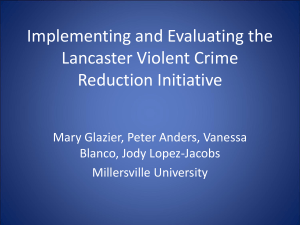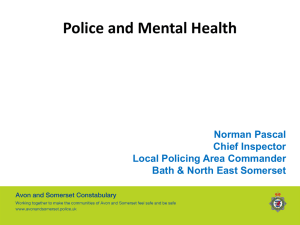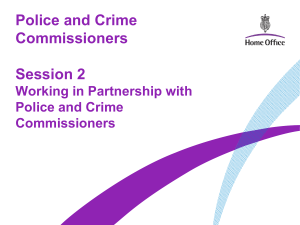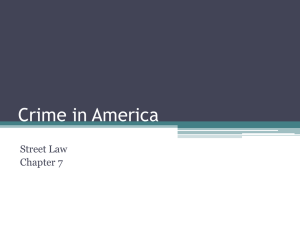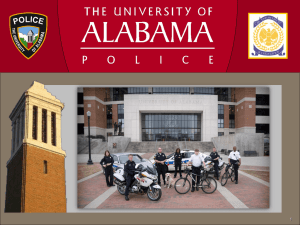Police and Policing
advertisement
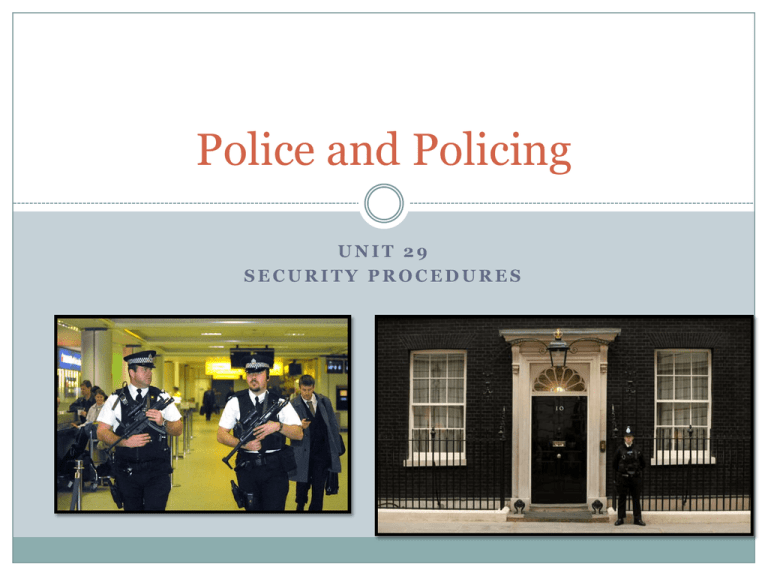
Police and Policing UNIT 29 SECURITY PROCEDURES Today’s Lesson Assignment Brief: 8th February 2013/Hand In. Who are the Police? What are the Security Threats to the UK Police? What are the Security Procedures in the UK Police? Assignment P1/M1/D1: Identify the Security threats to one UPS. P1: Describe the Security Threats. M1: Analyse the impact of these threats on the public service. D1: Analyse one threat in particular and go into detail with it. Why is a major threat and what impact does it have. Assignment P2/M2: P2: Outline the security procedures and the roles and responsibilities of Security workers in two UPS. M2: Explain these procedures analysing the positives and negatives and comparing them together. HAPPY??? Security Threats to the Police P1/M1/D1 Police Corruption Drugs Organised Crime Gun Crime/Knife Crime Police Corruption Police Corruption has definitely changed in the UK police in the last 40 years. 1970’s the British Police had major problems with corruption and there was alleged cases of brutal interrogations and miscarriages of justice. Types of Corruption Newburn 1999 shows that police corruption comes in many different types. Corruption of Authority: This is where officers receive money or gifts for information. ‘The Fix’: This is when officers undermine a investigation by destroying information. Direct Criminals Activities: When a officer commits an offence and is protected by colleagues. MAKE A TABLE!! Police Corruption The Phone Hacking Scandal Ian Tomlinson: G20 Protests Steven Lawrence: Alleged police corruption and racism was the reason why the Lawrence family did not receive justice. “Institutionally Racist”. Organised Crime/Mind Map Organised Crime has changed in the last 40 years. The Kray Twins (Local) Group Activity: Write down what you think would be hard or easy about policing the Krays. Transnational Organised Crime Gun Crime and Knife Crime Another major threat to the police is the use of knives and firearms within crime. As a result police are increasingly more likely to be a victim of either of these. Gun crime in the UK is low, with firearms only present in 10% of all murders committed in the UK. “Sharp Instruments” are the biggest risk to UK police and 40% of all violent crime involves wounding. Sharp Instruments Gun Crime Gun crime is extremely low with only 0.2% of all UK recorded crime and most of those weapons used were shown as air guns. What is interesting is that a large majority of all gun crime is committed in three areas: London/Manchester and Birmingham. Only 2.5% of the population are registered in the UK which is the lowest in Europe, however the illegal weapons market is growing. Armed Response Units http://www.youtube.com/watch?v=T5LfYLf41J4 CO19: Armed Units in London Reaction Tests Spot the Gun!! Drugs Drugs are a major threat to the UK police as they lead to crime and social problems. Class A: Cocaine/Heroin Class B: Ecstasy/ LSD Class C: Cannabis 50% of 16-24year olds claim to have used it at some stage. 65% of Crime in the UK has some link with drugs. Newburn 2007. Drugs http://www.youtube.com/watch?v=6FQllZYvKUs Group Work> What can we do about drugs? How do we police drugs and should they be legalised? Security Procedures in the Police Stop and Search Arrest and PACE (Police and Criminal Evidence Act) CCTV Forensics and Profiling Stop and Search Stop and Search was created during the late 1970’s and 1980’s. It was initially created to give the police greater powers of control but led to accusations of racial profiling and contributed to the Brixton Riots 1981. Stop and Search Stop and Search can be carried out only with “reasonable suspicion of crime or criminal activity”. PACE 1984 PACE: Police and Criminal Evidence Act 1984 Due to many cases of police corruption and miscarriages of justice during the 1960’s and 70’s, the government introduced PACE, which was legislation which protected the rights of a suspect. Guildford Four and the IRA bombings 1974. Torture and false confessions. Enhanced Interrogation techniques These are methods used by police and security services to get you to admit to a persons involvement in a crime. Want a little idea of what its like? Lights, Torch, stress positions and white noise. Stop and Search Stop and Search lets try it: Explain why you are searching me: Section 5 of the Road Traffic Act, no road tax. Search the person and the vehicle. Provide documentation to the suspect of what they have done. Problems?? PACE 1984 What security does PACE provide: Sets a time limit that a person can be held by the police before being charged. This is 36 hours or sometimes 60 hours. Suspects should receive medical attention if required. Suspects should receive food and water. If at risk of suicide, suspects should be watched and cared for. PACE 1984 Further to this: Police officers should inform suspects of their rights both verbally and via written notifications. A suspect can: -Consult a lawyer privately. -Telephone call -Receive Visits -Taped Interviews -CCTV to gather evidence. PACE and CCTV http://www.youtube.com/watch?v=7iRLNWeTQ8s http://www.youtube.com/watch?v=VSzf8WBIHfs What do we think? Write down the info about these case studies and a argument in favour of the police and against them. Sum Up What is Pace? What year was it created? Tell me some rights of a suspect? Forensics Forensics Forensics is the use of science to solve crime. -Photography: Crime scene is photographed. -Fingerprinting: Fingerprints are taken and compared. -DNA Testing: DNA is found in salvia, blood, hair, nasal secretions and semen. -Forensic Profiling: Understanding the mind of the killer or offender. DNA DNA can be found via: Our time to shine. We will now do some practical exercises to give you a little insight into Forensics. Fingerprinting DNA Swabbing Photography and a crime scene. Forensic Profiling This is used in Police work a little bit and it is when psychologists try to understand the mind of a killer and why people do what they do. -Childhood -Parents -Nature or Nurture -Teenage years -Socially Isolated -History of Abuse http://www.youtube.com/watch?v=qm1S_n0V5kk Let’s profile In groups you will be given a serial killer, I want you to pick out the key factors that you feel may have turned him into a serial killer.




